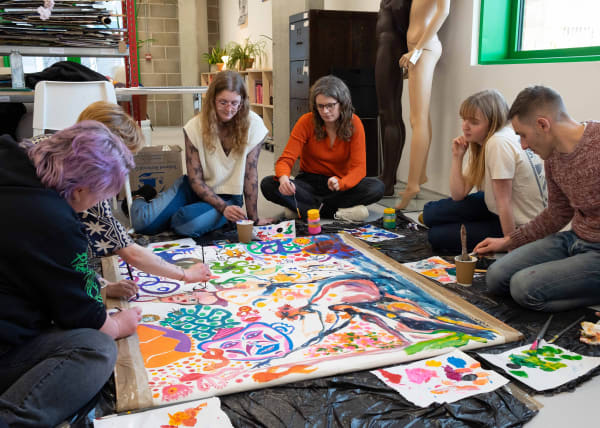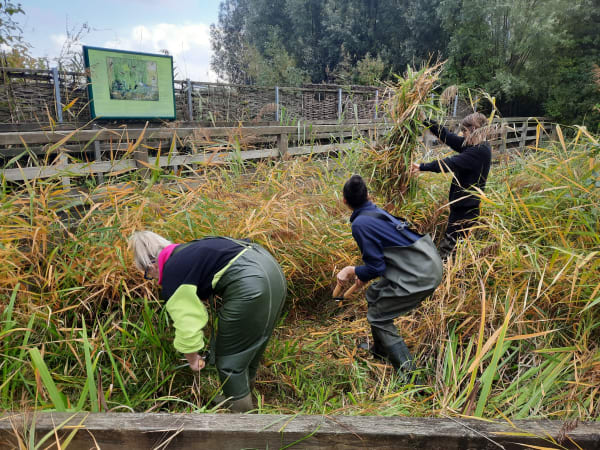-
Among the most common benefits people who take part in creative group activities notice are the positive social boost they feel, the new social connections they make, and the sense of community that can build – especially in groups that meet regularly over extended periods. This has been made widely clear across research into ‘arts and health’, ‘applied arts’ and ‘social practice’[1], and was also an outcome of the ‘Make Time’ activities.
In this exploration of the Make Time programme, Terence Wilde’s ‘Amid the Silent Flowers’, monthly textiles and embroidery workshops for gay men – was the most typical ‘Creative health’ style project. Artist Terence described how he’d imagined the project: “providing opportunities for social connections and friendship through developing specific skills and knowledge in a therapeutic space”. Month by month, bonds grew between group members: “We evolved from a group of strangers into a small community and collective of artisans creatively re empowering themselves in a nurturing space.” – Terrence. After 6 months Terence could clearly see positive social outcomes, even beyond those he’d imagined - “You could look in through the window and see men sewing and laughing, and talking to each other.”
-

-

-
How was this social bonding happening so quickly?
There are several potential drivers that might facilitate such readiness to create social connections in one-off Make Time sessions. In previous research an entire assemblage of creative facilitation practices emerged as extremely common, nationally and internationally, underpinning transformation processes in creative workshops[2]. Amongst these, one aspect – shared moments of intensity - stands out as particularly relevant, capable of building an atmosphere conducive to connecting very quickly person to person.
Shared moments of intensity are known amongst anthropologists to trigger a human phenomenon known as communitas (an idea created by Arnold van Gennep in 1960 and developed further by Victor Turner)[3]. With origins in ritual processes, or ritualised human events that involve intense moments of transition and change, communitas is characterised by a powerful sense of human connection. This can occur when people who don’t know each other share these experiences of unexpected intensity, or a depth of shared emotional revelation.
If encountered in large groups the sensation can border on euphoria (seen for example in some religious rituals, or music events/festivals[4]). The communitas state is outside the regular range of human experiences, and the resulting changes in how people feel about others involved in the same moment can be unexpected and seem other worldly – perhaps even magical or spiritual.
In David Shenton’s one-off queer cartooning workshop there were three factors that created a heightened intensity, or high stakes pressure, that all participants were experiencing together. Descriptions of the workshop experience show that social connections escalated under these conditions:
Firstly, participants’ drawing skills were immediately exposed and publicly tested (pressure of the risk of judgement by others, and of a failure to communicate through drawing) e.g. “It felt crazy how much concentration it takes to just put a few marks down. I kept saying how it felt like working completely in the dark, no idea how to capture the meanings visually! So just winging it at high speed on pretty full risk mode, and finding solidarity from those around me through the shared stress!!”
Secondly there was the fast pace of the workshop (intense time pressure to complete challenging tasks) e.g. “We completed at breakneck speed. Then went round to view each scenario - they were all amazing and the solidarity feeling was very strong in the room - it felt for me like we'd moved into new territory [socially].”
Thirdly the workshop’s subject of sharing our ‘coming out’ stories was deeply personal (the intensity of encountering our own personal disclosure boundaries – at speed). My field notes describe us becoming “bonded in the fire of disclosure”... “I applied everything I had to the task, because it mattered so much to me that I convey the sting of it....” Participants’ social defences lowered through this process, and a direct honesty became possible.
-
Below, David and I discuss a moment where social distance was unexpectedly bridged in this way between two very different participants:
“He suddenly addressed me directly. This attention moment struck me - he'd reached across the table, and across a gulf of age, gender, image and culture, it felt” -Anni “[He] went on such a journey – from quippy confident but guarded, performative young gay man, to coming out about all kinds of things all at once, and softening hugely by the very end...” - David
This encounter echoes anthropologist Victor Turner’s description of communitas enabling‘authenticity, [with] powerful social bonding as an outcome: “a direct, immediate, and total confrontation of human identities”; in communitas: “we place a high value on personal honesty, openness, and a lack of pretentions or pretentiousness. We feel it is important to relate directly to another person as he[5] presents himself in the here-and-now, to understand him in a sympathetic […] way.’’’[6]So, under these various pressure conditions “the solidarity feeling was very strong in the room...” and social barriers between strangers were unexpectedly vaulted. Field notes also record that “after the workshop finished people seemed attached, reluctant to leave the space, several stayed to chat”...“The final moment of producing and sharing all our stories, that vulnerability, guided so deftly by David, had created a kind of ‘communitas’, and left us in an afterglow suspension. So the bubble was hard to burst or break out of” - Anni -

-
Are these moments specific to QUEERCIRCLE sessions?
While these experiences creating unexpected levels of social bonds aren’t unique to QUEERCIRCLE sessions, it’s interesting that these conditions seemed to recur in one-off, short QUEERCIRCLE workshops. Echoing some discussion from blog 1 exploring ‘Identities and the Collective’ in Make Time sessions, perhaps the answer to this lies in the associations QUEERCIRCL itself has for participants. How they perceive the meanings of this unique space, and who they imagine will be present alongside them in any workshop are key factors. Assumptions that their (often difficult) lived experience related to their queer identities will be accepted and understood without even being voiced speeds up a trust-building process. Then the conditions may be pre-set for intense encounters and personal revelations (hallmarks of communitas) to happen. In a positive spiral of outcomes these moments can increase a sense of solidarity, and new social connections can suddenly open up in the space. If QUEERCIRCLE represents a kind of kinship space, with an expectation of reciprocal validation of the kind that participants might rarely find beyond known contacts, this can set the frame for new trusting bonds – like discovering a new ‘family’ amongst whom you feel affirmed.
-
[1] All-Party Parliamentary Group on Arts, Health and Wellbeing Inquiry Report (2017) Creative Health: The Arts for Health and Wellbeing; Raw, A. (2013) 'A model and theory of community-based arts and health practice'; WHO (2019) Regional Office for Europe: Health Evidence Network Synthesis Report 67 ‘What is the evidence on the role of the arts in improving health and well-being?’ Daisy Fancourt, Saoirse Finn; The Jameel Arts & Health Lab in collaboration with the WHO–Lancet Global Series on the Health Benefits of the Arts, Sajnani, Nisha et al. The Lancet, Volume 402, Issue 10414, 1732 - 173
[2] Raw, A. (2013) 'A model and theory of community-based arts and health practice'; and Raw, A. (2014) Ethnographic Evidence of an Emerging Transnational Arts Practice? Perspectives on UK and Mexican Participatory Artists’ Processes for Catalysing Change and Facilitating Health and Flourishing. Anthropology in Action, 21(1), 13-2.
[3] Van Gennep’s The Rites of Passage, 1960; Victor Turner – various publications☹1967, 1969, 1974, 1979) & specifically (2002): Liminality and Communitas. In M. Lambek (Ed.), A Reader in
the Anthropology of Religion. Oxford: Blackwell Publishing.
[4] O’Grady, A. (2012) Spaces of Play: The spatial dimensions of underground club culture and locating the subjunctive. Dancecult: Journal of Electronic Dance Music Culture 4(1):86-106
[5] Gender specificity used by the cited author here is not relevant to the intended meaning of the idea discussed, and should be read as gender neutral (not sure how to say this!! Any ideas?
[6] (Turner, 1982, p. 48) quoted in Raw (2013, p. 344-5) – see endnote 1 above






